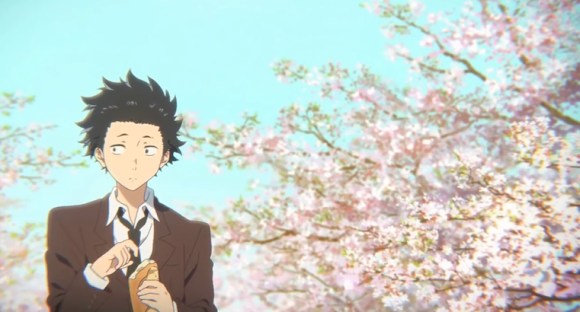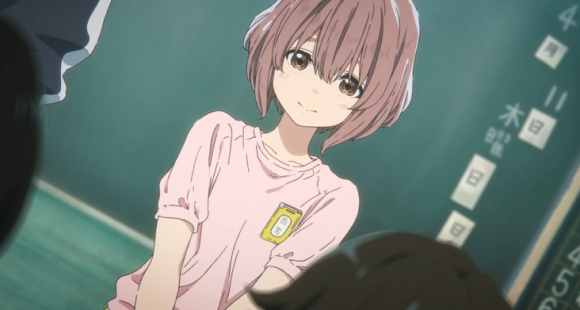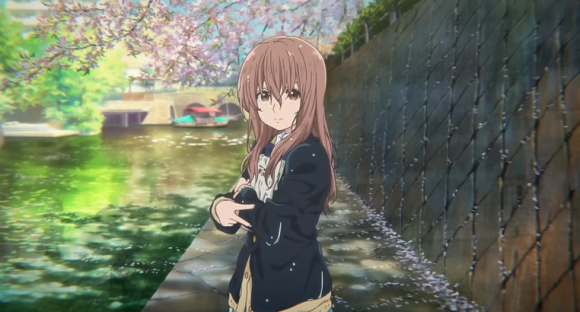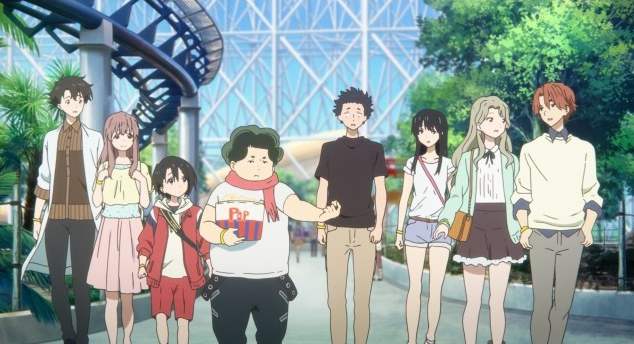A Silent Voice
January 31, 2017 · 0 comments
By Andrew Osmond.
 At last year’s Scotland Loves Anime event, the festival judges had to decide which of the films was the best (you can listen to their comments here).The prize went to Your Name, but only by a narrow margin – the votes split almost equally between Shinkai’s blockbuster and a very different film which opened in Japan at nearly the same time. That was A Silent Voice, by the famed Kyoto Animation studio, but Kyoto Animation as you’ve never seen it before.
At last year’s Scotland Loves Anime event, the festival judges had to decide which of the films was the best (you can listen to their comments here).The prize went to Your Name, but only by a narrow margin – the votes split almost equally between Shinkai’s blockbuster and a very different film which opened in Japan at nearly the same time. That was A Silent Voice, by the famed Kyoto Animation studio, but Kyoto Animation as you’ve never seen it before.
True, A Silent Voice sounds familiar in broad terms. It’s an emotional (very emotional) drama about a group of Japanese youngsters, girls and boys. But few anime dramas are so intense. Whereas A Silent Voice has humour, and some charming characterisation of the kind you’d expect from the studio behind K-ON! and Free!, it foregrounds darker emotions. It’s a film about guilt, resentment, hate and self-loathing. And its story is triggered by an act of bullying; by children who bully a more vulnerable child.
In the first section of the film, we meet Shoya Ishida, a primary-school boy. He’s mischievous, a daredevil, well-liked by his classmates. He’s a normal, buoyant, cute kid. But unlike the vast majority of anime, A Silent Voice acknowledges that “normal” kids aren’t always upstanding and kind. Given the right circumstances, they can be cruel, even monstrous.
 A new pupil joins Shoya’s class; a shy, quiet girl called Shoko. Shoko’s deaf: she depends on costly hearing aids, and has trouble speaking, having never heard her own voice. She prefers to communicate through writing on the notepad she carries, or by sign language. The teachers tell the other kids to be considerate to Shoko – for example, to learn sign language themselves so they can better “talk” to her.
A new pupil joins Shoya’s class; a shy, quiet girl called Shoko. Shoko’s deaf: she depends on costly hearing aids, and has trouble speaking, having never heard her own voice. She prefers to communicate through writing on the notepad she carries, or by sign language. The teachers tell the other kids to be considerate to Shoko – for example, to learn sign language themselves so they can better “talk” to her.
But kids are kids. They’re annoyed at being told to make allowances for this newcomer, and Shoya is particularly irked. He starts to tease Shoko; how funny, this girl who can’t hear what he’s doing behind her back. The pranks quickly become aggressive. Some of the other kids find it hilarious; none of them stop Shoya. These scenes, unsurprisingly, are painful to watch for anyone who was bullied, or who was a bully – and let’s face it, many kids were both.
Shoya experiences both sides himself. Eventually, his bullying rebounds; suddenly the other kids in the class are hating him, rejecting him. What he did to Shoko comes to define him, both in the eyes of his peers and for Shoya himself. He’s no longer the cool class clown. He’s just the mean bully, so low he picked on a deaf girl. How can he deserve to be worth anything? Wouldn’t the world be better without him?
All of the above happens in the opening section. The main story is set five years later, when Shoko’s a friendless teen. In one of the film’s most vivid images, all his high-school classmates have “X” crosses on their faces. He can’t talk to them, he’s not even the same species. His life is pointless; he stands in high places and dreams of letting himself fall. He’s only a teenager, but his story is over. He blew his life.
And then he meets Shoko again, and…
 Well, more characters come into the story; some old acquaintances from primary school, and some new faces. One of the newcomers is a heartbreakingly needy overweight boy, Tomohiro, who forcibly adopts Shoya as his friend, knowing nothing of his background. He lightens the film up considerably after the traumatic opening. But Shoya is still troubled. Why is he bothering Shoko again, after what happened? Isn’t he being utterly selfish, looking for forgiveness he doesn’t deserve?
Well, more characters come into the story; some old acquaintances from primary school, and some new faces. One of the newcomers is a heartbreakingly needy overweight boy, Tomohiro, who forcibly adopts Shoya as his friend, knowing nothing of his background. He lightens the film up considerably after the traumatic opening. But Shoya is still troubled. Why is he bothering Shoko again, after what happened? Isn’t he being utterly selfish, looking for forgiveness he doesn’t deserve?
The story broadens out: after all, Shoya’s acquaintances have their own issues from five years ago. One of them blames, not Shoya but Shoko, infuriated by her eternal victimhood. And what of Shoko herself? She seems so sweet, so gentle, even after everything that’s happened to her. But is her accepting attitude as corrosive to her development as Shoya’s past cruelty is to his? These characters are still kids. The next time things screw up between them, the consequences could be far, far worse…
At the film’s British premiere at SLA last year, many of the audience already knew A Silent Voice. The film is based on a manga by Yoshitoki Oima, available in English in seven volumes. (Volume 7 is the end, by the way – the film benefits hugely from being able to depict the manga’s whole “arc,” even if many subplots and details are dropped.) It’s likely that many anime/manga fans were drawn to the film because of the manga, rather than because of the Kyoto Animation connection.
 Or rather the K-ON! connection. Both Silent Voice’s director, Naoko Yamada and its writer, Reiko Yoshida, worked on the K-ON! franchise from start to finish, including the London-set movie in 2011. The following year, Yamada came to Scotland Loves Anime in Glasgow. According to one report, she doesn’t see herself as a director with a distinctive style – unlike, say, Makoto Shinkai – but rather a director who focuses on getting into the characters’ minds. She said she’d prefer fans to see her anime, enjoy them, and then find out she directed them – the work comes first.
Or rather the K-ON! connection. Both Silent Voice’s director, Naoko Yamada and its writer, Reiko Yoshida, worked on the K-ON! franchise from start to finish, including the London-set movie in 2011. The following year, Yamada came to Scotland Loves Anime in Glasgow. According to one report, she doesn’t see herself as a director with a distinctive style – unlike, say, Makoto Shinkai – but rather a director who focuses on getting into the characters’ minds. She said she’d prefer fans to see her anime, enjoy them, and then find out she directed them – the work comes first.
Obviously, A Silent Voice is far more intense than K-ON! in subject and emotions. While K-ON! has already had a stylistic sequel – the similar-looking Tamako Market, on which Yamada and Yoshida also teamed – there’s no attempt to make A Silent Voice look like part of the same brand. Manga quirks are preserved on screen, such as Tomohiro’s unusual design (his hairdo makes Princess Leia’s look conservative) and the X’s which Shoya sees on everyone’s faces. Japanese trailers like this one don’t try to link the film to Kyoto Animation’s lighter titles; they play up the film’s intensity from the opening seconds.
Whereas Your Name was a brilliant “genre” (or cross-genre) work, A Silent Voice breaks new ground. There are other anime which tell stories of intense, painful teen feelings; most, though, use fantasy or quasi-fantasy devices (for example, Keiichi Hara’s Colourful), or a surfeit of goofy comedy or feel-good nostalgia before they get serious. A Silent Voice has the faith in its characters to go past that; as such, it might be as important in anime as any other recent movie.
A Silent Voice is one of the films in the Japan Foundation UK tour, starting on 3rd February. Director Naoko Yamada will be appearing at a screening of the film in Glasgow on 23rd February.
Leave a Reply